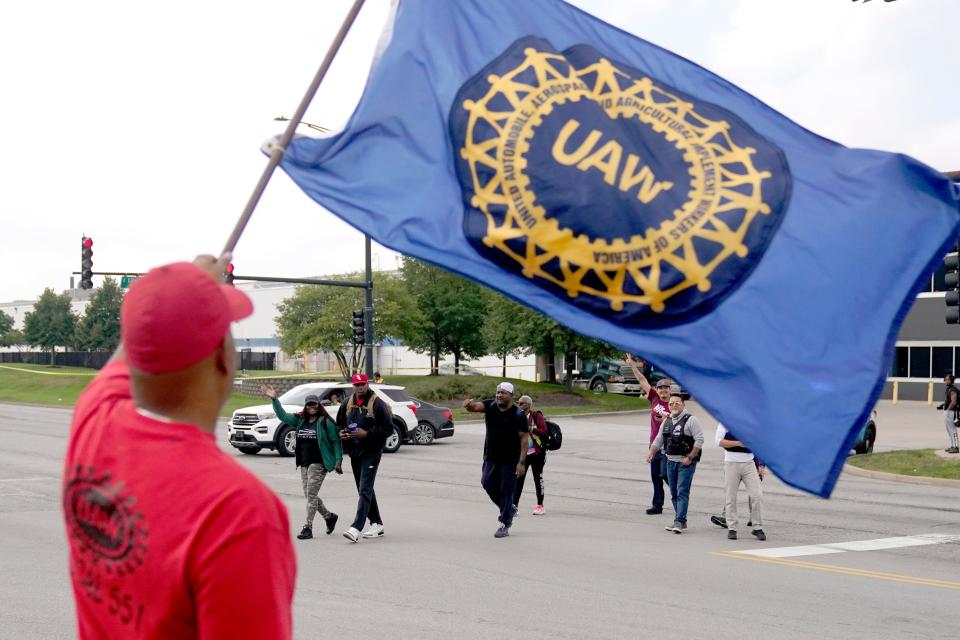UAW strike: 400 laid off from Ohio Ford plant, while GM OKs new workers in contract

More: 'Our strike is working:' UAW president says fight is ongoing with Big Three automakers
United Auto Workers union President Shawn Fain said in a live broadcast Friday that the Big Three automakers are giving in to demands for "a record contract" based on "record profits," announcing that General Motors is the first to agree to put battery manufacturing workers under the UAW national labor agreement.
But while UAW is reporting progress in negotiations, some union workers are starting to feel the pain. Also on Friday, Ford notified nearly 400 union workers they will be laid off from the Ford Cleveland Engine Plant No. 1 in Brook Park due to the strike, Beacon Journal partner News 5 Cleveland reported Friday.
UAW 1250 spokesman Pat Wallace told News 5 that 375 employees from the I-4 engine building — nearly a quarter of the plant's 1,700 employees — are being laid off because other locations that receive parts from the Ford plant are on strike.
The layoffs come after hundreds of other auto worker layoffs were announced earlier in the week. Ford said this week it was furloughing a total of 330 workers at its Chicago and Lima, Ohio, plants, and GM announced it would lay off 164 workers at its Parma, Ohio, and Marion, Indiana, metal centers, News 5 reported.

Fain: Strike threat gained battery concession
Wearing a T-shirt that said "Eat the Rich" in bold black letters, Fain said the strike is succeeding. He characterized the struggle as a sort of class war.
"The billionaires and company executives think all us old workers are just dumb. They think we don't get it. They think we only understand the power of a supervisor yelling at us or an assembly line coming at us," he said. "...We've been very careful about how we escalate this strike, and we have designed this strategy to increase pressure on the companies, not to hurt them for its own sake, but to move them, to get them to say 'yes' when they want to say 'no,' and today is a perfect example of that."
He said the union had been preparing to shut down GM's Arlington Assembly plant in Texas, which employs 5,300 workers and manufactures thousands of SUVs per month, when the automaker agreed to include workers who manufacture batteries in the master contract.
Fain said the concession prevents such workers from being kept at lower-wage scales as vehicle manufacturing transitions from internal combustion to electric.
More: The South — and its batteries — looms over the autoworkers strike
"We were about to shut down GM's largest money maker in Arlington, Texas," Fain said. "The company knew those members were ready to walk immediately. Just that threat provided a transformative win."
GM currently has a battery plant in Lordstown called Ultium Cells LLC, which is a joint venture with LG Energy Solutions.
GM did not respond to a request for confirmation of the concession by USA Today Network partner Detroit Free Press, but the company issued a statement Friday afternoon: “Negotiations remain ongoing, and we will continue to work towards finding solutions to address outstanding issues. Our goal remains to reach an agreement that rewards our employees and allows GM to be successful into the future.”
Fain said he expects Ford and Stellantis to follow GM as negotiations proceed.
'Our strike is working'
Fain said that before the battery concession, GM had been "falling behind" the other two manufacturers in concessions but had "leap-frogged ahead."
"Our strike is working, but we're not there yet," Fain said. "Everything we've done to this point has been with one goal in mind: To win a record contract that reflects the Big Three's record profits and the historic sacrifices our members have made to generate those profits."
Fain said the union has made significant progress in the following ways:
Ford has gone from proposing a 9% wage increase to 23%, with the other two companies proposing 20%.
Ford and GM have committed to offering cost of living salary adjustments.
GM and Stellantis have agreed to give temporary workers raises to $20 per hour, with $21 per hour moving forward. And all three automakers have made commitments around converting temps to full-time.
Automakers have agreed to lowering the time on the job it takes for workers to get to full-scale wage from eight years to three (Ford) and to four years (GM and Stellantis).
Negotiations are also continuing on profit sharing, the right to strike over plant closures, added allowances for skilled trade workers and retirement security.
More: UAW strike against automakers expands to 38 plants, including Streetsboro
The strike began as the UAW union contract expired Sept. 14, and it expanded Sept. 22 to include around 13,000 of the union's 146,000 members.
GM earned $10 billion in net profits in 2022, USA Today reported. Ford reported increased earnings, although one-time charges left them with a net loss, while Stellantis received nearly $18 billion in net profits.
Ford CEO James Farley said at the start of the strikes that meeting the UAW's terms could drive the company into bankruptcy.
Fain said the union is fighting for "economic justice."
"The Big Three know we're not messing around, and they know if they want to avoid further strikes, then they will have to pony up," he said.
Eric Marotta can be reached at emarotta@gannett.com.
This article originally appeared on Akron Beacon Journal: Nearly 400 layoffs at Ford Brook Park plant as UAW leader cites progress

